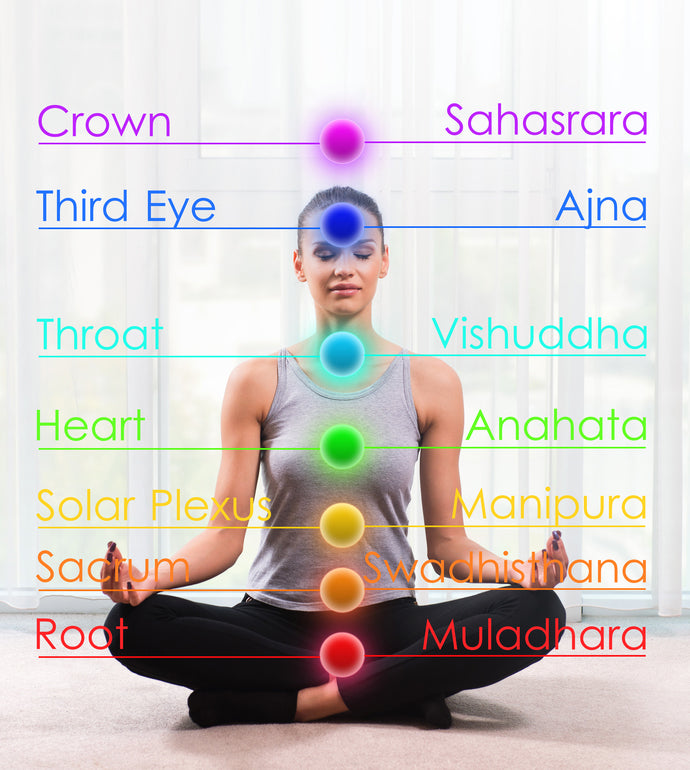What are Chakras and How Can You Balance Them?

A Holistic Approach to Realigning Your Chakras
When we aren’t feeling our best and need to reset our mind and body, Source Vitál Apothecary looks to holistic wellness techniques to fill the void. One of our favorite ways to reset our internal alignment is through realigning our chakras.
With firm roots in Indian and Tibetan traditions, chakras are mentioned in both Hindu and Buddhist texts. They are described as the seven energy centers located in specific parts of the body, ranging from the head (or crown) to the base of the spine.
In Sanskrit, chakra means “wheel” or “circle.” To visualize the chakras within the body, imagine a rotating hub of energy where your physical body and consciousness meet. This point of energy, or prana, is considered to be our life force, and it helps to keep our feelings and emotions in check.
Why is Balancing Your Chakras Necessary?
Achieving balance is important for a variety of reasons. When we get off-kilter or feel emotionally frustrated, it is believed that this may be due to blocked energy in one or more of our chakras. When your chakras are blocked or working inefficiently, they can cause an associated physical or emotional symptom in the body.
If you are clearing negative energy from a chakra center, it is important to not leave it exposed to more negativity. Our energy takes the path of least resistance, which is why it’s important to clear the chakra and replace negative energy with positive as promptly as possible. A chakra that is filled with positive energy creates what we’re looking for – balance.
To help you better understand your chakras, why they might be skewed out of alignment, and how to balance them, we’ve compiled this simple guide.

The 1st Chakra, “Muladhara”
- The “Root Chakra”
- Color: Red
- Location: Base of the spine
- Symptoms of a blocked chakra:
- Feeling unsafe or insecure
The first or root chakra represents your foundation and your emotions revolving around feeling stable and secure in all elements of survival. This can mean shelter, food, or even finances. When the base chakra is open, you feel safe and secure. An overactive root chakra can make you feel anxious, invoking a “fight or flight” response.
To balance the root chakra, focus on the color red while meditating or try a few grounding poses during yoga, such as tree pose.
The 2nd Chakra, “Svadhisthana”
- The “Sacral Chakra”
- Color: Orange
- Location: Below the belly button
- Symptoms of a blocked chakra:
- Feeling sexually frustrated
- Loss of body awareness
The sacral chakra is the center of your sensuality, creativity, and passion. When open, the sacral chakra allows you to “feel” the world around you and inside you more effectively. It is associated with emotions, relationships, and sexuality.
To balance the sacral chakra, visualize an orange lotus or crescent moon in your mind’s eye during your meditation. For yoga practitioners, try hip-opening poses like half pigeon to release any negative emotional energy.
The 3rd Chakra, “Manipura”
- The “Solar Plexus Chakra”
- Color: Yellow
- Location: From the belly button to the breast bone
- Symptoms of a blocked chakra:
- Feeling angry or resentful
The Solar Plexus Chakra represents who you are – your personality, self-worth, and ego. When unbalanced, the solar plexus chakra can leave you feeling selfish and manipulative. When properly aligned, it allows for feelings of confidence and power.
Meditate on feelings and attitudes of confidence to restore balance to the solar plexus chakra. We recommend core-stimulating yoga poses like boat pose as well.
The 4th Chakra, “Anahata”
- The “Heart Chakra”
- Color: Green
- Location: Directly over the heart
- Symptoms of a blocked chakra:
- Difficulty communicating feelings
- Feeling too vulnerable
- Feeling closed off
The heart chakra is associated with your ability to give and receive love. When open, you feel love, compassion, and grace. When the heart chakra is closed, feelings of anger, jealousy, and even hatred can manifest. Located in the very center of the seven chakras, the heart chakra unites the lower matter chakras with the upper spirit chakras.
Bring balance to your heart chakra by adding a positive mantra to your meditations or perform heart-opening yoga poses such as upward facing dog.
The 5th Chakra, “Vishuddha”
- The “Throat Chakra”
- Color: Blue
- Location: Over the throat
- Symptoms of a blocked chakra:
- Coughing
- Feeling like you will cry
The throat chakra represents communication and self-expression. When open, you’re able to communicate with confidence. When blocked, it can leave you with feelings of self-doubt.
To clear negative energy from the throat chakra, focus on breathing directly into your throat during your meditation. Imagine your breath as a blue light that shines stronger with each inhalation. In your yoga practice, incorporate poses that stretch your neck and upper back.
The 6th Chakra, “Ajna”
- The “Third Eye Chakra”
- Color: Purple
- Location: Between the eyebrows
- Symptoms of a blocked chakra:
- Sinus tension
- Fatigue
The third eye chakra represents your ability to make decisions and focus. It is where your wisdom, common sense, memory, dreams, and intuition live. When well-balanced, it can help you feel decisive and imaginative. When unbalanced, you can feel a lack of clarity or direction in your life.
Child’s pose is especially helpful in balancing the third eye chakra. During meditation, bring your awareness to your third eye by focusing on that space between your eyebrows.
The 7th Chakra, “Sahaswara”
- The “Crown Chakra”
- Color: White
- Location: The top of the head
- Symptoms of a blocked chakra:
- Headaches
- Difficulty Sleeping
- Feelings of insecurity
Our highest chakra is the crown chakra. It is your connection to your sense of spirituality, or your highest self. When off-balance, you can feel disconnected from your spirituality.
Connect to your crown chakra by practicing a Divine Light Meditation or entering into a simple savasana, or corpse pose.
Taking the time to really reflect on the physical and emotional cues within our body can seem overwhelming – especially if you don’t know how to listen to them or respond in a beneficial manner. But the benefits of taking the time to re-center ourselves are innumerable. And even if you don’t necessarily believe in the idea of chakras, there is ample value in working to truly understand what's going on internally, physically, emotionally, and spiritually with your mind, body, heart, and soul.

